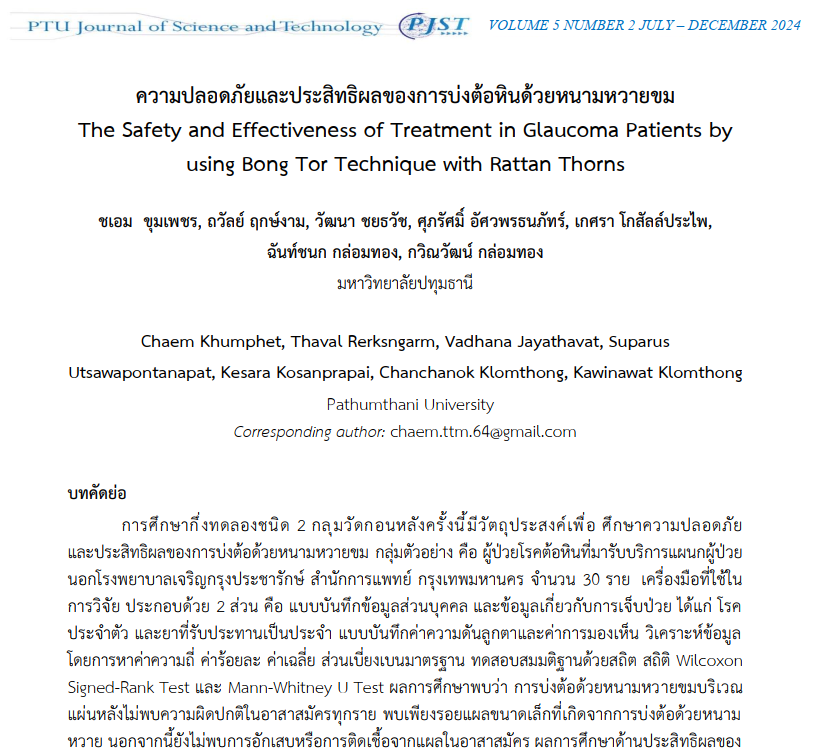The Safety and Effectiveness of Treatment in Glaucoma Patients by using Bong Tor Technique with Rattan Thorns
Main Article Content
Abstract
This Quasi-Experimental Research with two-group pretest-posttest design aimed to investigate the safety and the effectiveness of glaucoma treatment using bong-tor with rattan thorn. The study population consisted of glaucoma patients who received treatment at the outpatient department of Charoenkrung Pracharak Hospital, Medical Services Department, Bangkok was 30 patients. The research instrument consists of 2 parts: a personal data record form and information about illness, including congenital diseases and medications taken regularly Form for recording intraocular pressure and visual acuity values. Data analysis was frequency, percentage, mean, and standard deviation, with statistical hypothesis testing Wilcoxon Signed-Rank Test and Mann-Whitney U Test. The findings revealed that: The safety of bong-tor with rattan thorn on the back showed no abnormalities in the volunteers, with only minor wounds caused by the pricking the needle, and no signs of inflammation or infection in the volunteers. The effectiveness of bong-tor with rattan thorn in reducing intraocular pressure was statistically significant at the 0.014 level, with post-experimental intraocular pressure levels significantly lower than pre-experimental levels in the left eye and the right eye statistically significant too at the 0.019 level. The visibility value was found to be the visual acuity values pre and post- experimental were not different. Benefits from this study you will receive information that confirms safety. And the effectiveness of treating glaucoma with bitter rattan thorns which can be used to develop or prepare medical practice guidelines and professional standards in Thai traditional medicine
Article Details

This work is licensed under a Creative Commons Attribution-NonCommercial-NoDerivatives 4.0 International License.
ความคิดเห็นและข้อเสนอแนะใดๆ ที่นำเสนอในบทความเป็นของผู้เขียนแต่เพียงผู้เดียว โดยบรรณาธิการ กองบรรณาธิการ และคณะกรรมการวารสารวิทยาศาสตร์และเทคโนโลยี มหาวิทยาลัยปทุมธานี ไม่ได้มีส่วนเกี่ยวข้องแต่อย่างใด มหาวิทยาลัย บรรณาธิการ และกองบรรณาธิการจะไม่รับผิดชอบต่อข้อผิดพลาดหรือผลที่เกิดจากการใช้ข้อมูลที่ปรากฏในวารสารฉบับนี้
References
คณะกรรมการพัฒนาระบบบริการที่ตอบสนองต่อปัญหาสุขภาพที่สำคัญ(สาขาจักษุ). (2556). แนวทางพัฒนาระบบบริการสุขภาพสาขาจักษุวิทยา. กรุงเทพฯ : โรงพิมพ์ชุมนุมสหกรณ์การเกษตรแห่งประเทศไทย จำกัด.
จิตอนุวัต พุ่มม่วง และคณะ. (2563). “การศึกษาโครงสร้างของเนื้อเยื่อหลังการรักษาด้วยการบ่งต้อลมบริเวณหลังจากศาสตร์การแพทย์แผนไทย,” ใน วารสารการแพทย์แผนไทย และการแพทย์ทางเลือก. ปีที่ 18 ฉบับที่ 2 พฤษภาคม - สิงหาคม (ฉบับเสริม).
ดวงทิพย์ รักสนิท. (2558). “ปัจจัยที่มีความสัมพันธ์กับการควบคุมความดันในลูกตาของผู้ป่วยโรคต้อหิน ปฐมภูมิที่แผนกผู้ป่วยนอกโรงพยาบาลพระมงกุฎเกล้า,” ใน วารสารพยาบาลทหารบก. ปีที่ 16 (ฉบับที่ 1) : หน้า 109 - 115
ประกาศสภาแพทย์แผนไทย เรื่อง เกณฑ์มาตรฐานและกรรมวิธีการแพทย์แผนไทยผู้ประกอบวิชาชีพการแพทย์แผนไทยตามพระราชบัญญัติวิชาชีพการแพทย์แผนไทย พ.ศ. 2556 . (2563, 15 กรกฎาคม). ราชกิจจานุเบกษา. เล่ม 137 ตอนพิศษ 162 ง. หน้า 27.
ภาณิกานต์ คงนันทะ. (2553). ปัจจัยที่มีอิทธิพลต่อการเลือกใช้บริการนวดแผนไทยของนักท่องเที่ยวต่างชาติบนถนนข้าวสาร กรุงเทพมหานคร. วิทยานิพนธ์ปรัชญาดุษฎีบัณฑิต. สาขาวิชาการจัดการภาครัฐและภาคเอกชน. มหาวิทยาลัยศิลปากร.
ศิริลักษณ์ กิจศรีไพศาล และ ปรัศนีย์ พันธุ์กสิกร. (2019). ความร่วมมือในการรักษาของผู้ป่วยต้อหิน : การวิจัยเชิงคุณภาพ. Thai Journal of Nursing Council, 34(4), 21.
สายจิต สุขหนู และคณะ. (2564). การศึกษาองค์ความรู้พื้นบ้านในการรักษาโรคต้อกระจก โดยการบ่งต้อด้วยหนามหวายขม กรณีศึกษาหมอชเอม ขุมเพชร. วารสารหมอยาไทยวิจัย ปีที่ 7 ฉบับที่ 1 (มกราคม – มิถุนายน 2564).
Khaw, P. T., & Elkington, A. R. (2004). Glaucoma 1 : diagnosis. Bmj, 328 (7431), 97-99.
World Health Organization (WHO). [Online]. (2021). Blindness and Vision Impairment. Retrieved from : https://www.who.int/news-room/fact-sheets/detail/blindness-and-visual-impairment.
World Health Organization (WHO). [Online]. (2023). Blindness and Vision Impairment. Retrieved from : https://www.who.int/news-room/fact-sheets/detail/blindness-and-visual-impairment.

